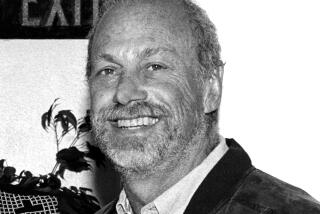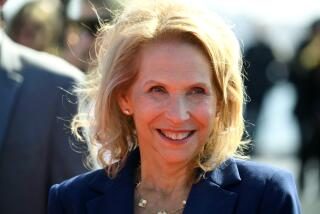DirecTV pioneer to take Times reins
Eddy Hartenstein, the former head of satellite television provider DirecTV, will become the new publisher of the Los Angeles Times on Monday.
Hartenstein said Friday that he would fill the post vacated when publisher David Hiller resigned July 14, the same day parent company Tribune Co. began implementing the latest round of staff cutbacks at the paper.
Hartenstein takes over at a time when The Times and most other newspapers are losing readers and advertising revenue at a significant rate. Some observers are even questioning whether the newspaper business as currently constituted can survive.
“I’m not coming into this with blinders on,” said Hartenstein, 57. “I realize that the problems are huge and daunting, but I don’t believe there’s anything that can’t be fixed as long as everyone is pulling in the same direction.”
An avid reader of The Times since his boyhood in Alhambra, he said, “I love challenges. I love complex issues and problems, and this certainly met all that.”
Sam Zell, who has led Tribune since taking the Chicago-based media company private last December, approached the former satellite TV executive about becoming publisher about a month ago, said Hartenstein, who met Zell for the first time last fall.
After mulling it over and doing some research -- which included a 3 1/2 -hour lunch with Times Editor Russ Stanton -- Hartenstein agreed to take the job.
“I wanted to know that I would have the ability . . . to call the shots,” said Hartenstein, who said his new boss made no demands concerning future staff cuts. Zell “basically said, ‘You’re the publisher and CEO. It’s yours to run,’ and that was pretty much it.”
Hartenstein said he also sought assurances that Zell had no intention to simply “dress up the paper for a sale.”
“One of the questions I asked Sam was: Are you going to keep this?” Hartenstein said. The answer “was a strong, affirmative ‘Yes. This is a keeper.’ ”
The Times has been particularly hard hit by the current turmoil in the newspaper industry. Its daily circulation has tumbled from a peak of 1.2 million in the early 1990s to about 774,000 this year while advertising revenue has slumped. Traffic to the paper’s website, at latimes.com, has increased sharply in recent years but that has not offset the declines in advertising.
Management turnover has accompanied the circulation decline. Hartenstein will be The Times’ fourth publisher since Tribune acquired the paper in 2000. The paper has had four editors since 2005. Hartenstein said he had “no intention of changing the editor of the Los Angeles Times.”
His appointment continues Zell’s tendency to name former executives from electronic media to positions within Tribune, including Chief Operating Officer Randy Michaels, a former radio executive.
Friends and associates say Hartenstein, regarded by many as the father of the satellite TV industry, combines the analytical thinking of a Caltech-educated engineer -- which he is -- with the people skills needed to lead a complex, consumer-oriented organization, which he also happens to have done.
“He’ll meet you once and he won’t forget your name, he won’t forget what you do -- and he’ll care about all of that,” said Stanley E. Hubbard, chief executive of Hubbard Media Group in St. Paul, Minn., who has worked with Hartenstein in the past. “It’s a very refreshing way for a senior leader to be.”
He left a positive impression at the Glendora offices of the National Hot Rod Assn., which was working with an investment group headed by Hartenstein on a $121-million deal to turn the drag racing organization into a mini-NASCAR. The deal abruptly fell apart in February after 18 months of work. With the credit crisis on Wall Street worsening by the day, what had seemed a good deal a year earlier was no longer viable.
“The market conditions were the driving force behind it not happening,” said association President Tom Compton, who worked with Hartenstein and his investors. “Those guys are very bright guys. If they couldn’t get it done, I’m not sure who could’ve.”
It was a rare setback for Hartenstein, whose career path has been mostly upward. After graduating from Cal Poly Pomona in 1972 with degrees in math and aerospace engineering, he went to work for El Segundo-based Hughes Electronics Corp., a defense contractor and satellite maker that was later acquired by General Motors Corp.
While pursuing a master’s in applied mechanics at Caltech in his spare time, Hartenstein was moving up the ladder at Hughes and germinating an idea that would shake up the television industry: using satellites and digital technologies to deliver programming to viewers’ homes. Not only would the sound and picture be sharper, satellite TV would make an end run around local cable monopolies, he reasoned.
In the early ‘90s, Hartenstein persuaded his bosses at GM to finance the venture that would become DirecTV Group Inc. In 1994, DirecTV revolutionized the satellite TV business when it introduced a small receiving dish that could be mounted on a rooftop or apartment balcony, eliminating the need for the wading-pool-sized backyard dishes that had been the standard until then.
The innovation helped win over reluctant consumers and also gave DirecTV a leg up on rivals. Hartenstein, who had been president of DirecTV since its inception and was named chairman and CEO in 2001, distinguished the pioneering medium from its cable competitors by improving customer service and offering innovative packages of sports programming.
By the time he left at the end of 2004, a year after GM sold its stake in DirecTV to Rupert Murdoch’s News Corp., the company was among the nation’s top pay television providers, with 13.9 million subscribers.
Associates say DirecTV’s growth illustrates Hartenstein’s ability to combine technical innovation with customer-oriented initiatives, shedding when necessary the numbers-driven, pocket-protector persona generally associated with engineers to focus on the commercial aspects of the business.
Other than the failed deal with the drag-racing group, Hartenstein has kept a fairly low profile since leaving DirecTV, serving on the boards of SanDisk Corp., XM Satellite Radio Holdings Inc., Broadcom Corp. and the City of Hope hospital in Duarte.
Although well known in the industry (he’s a member of the Broadcasting & Cable Hall of Fame and received a lifetime achievement Emmy last year), Hartenstein isn’t exactly a household name. The Wikipedia page for Alhambra High School doesn’t even list him on the roster of notable alums, which includes model Cheryl Tiegs and Hillary Rodham Clinton’s mother.
“He doesn’t go to the annual gatherings of industry big shots,” said Brian Lamb, CEO of C-SPAN and a longtime friend. “He’s not a high roller.”
Whether Hartenstein’s success at building a business from scratch translates to a declining industry that’s under assault from a range of newly sprouted competitors remains to be seen. Those who have worked with him say he’s adept at choosing effective lieutenants, which could help compensate for his lack of publishing experience.
“Eddy knows what he knows and he knows what he doesn’t know,” said Compton of the National Hot Rod Assn.
Efforts to reinvent the traditional daily paper so far have failed to gain traction with subscribers, advertisers or investors. At The Times, in addition to halting the slide in circulation, Hartenstein will need to lure advertisers back to the paper and to the website and shore up a demoralized staff.
Even so, those who know Hartenstein don’t expect him to make changes impulsively.
“Eddy’s not a guy to panic,” said Joe Clayton, former chairman of Sirius Satellite Radio. “When things get difficult, he remains calm. He’ll assess the situation, get a consensus and then make an appropriate decision.”
--
More to Read
The biggest entertainment stories
Get our big stories about Hollywood, film, television, music, arts, culture and more right in your inbox as soon as they publish.
You may occasionally receive promotional content from the Los Angeles Times.










